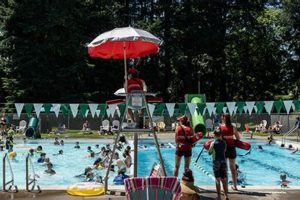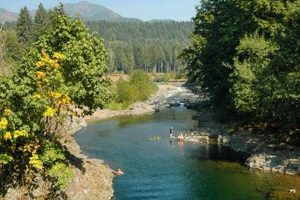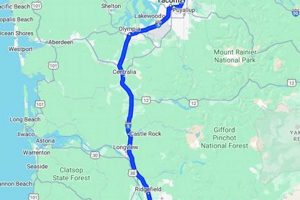Airborne allergens in the Portland, Oregon area, commonly originate from trees, grasses, and weeds. These microscopic particles, released into the atmosphere, serve as the male reproductive agents of various plant species. Seasonal variations significantly impact the concentration and type of these allergens present in the air of the Portland metropolitan region.
Understanding the prevalence and types of these airborne allergens is important for public health. Historical data, coupled with current monitoring, provides insight into the cyclical nature of allergen seasons, allowing individuals susceptible to allergic reactions to take preventive measures. This information is also crucial for healthcare providers in diagnosing and managing allergy-related conditions within the local population.
The following sections will delve into specific types of allergens common in the Portland area, seasonal trends, and available resources for monitoring and managing exposure.
Managing Seasonal Allergens in the Portland Area
The following guidelines offer strategies for mitigating the effects of airborne allergens prevalent in the Portland, Oregon area.
Tip 1: Monitor Allergen Levels. Regularly consult local pollen forecasts, available through various weather services and allergy tracking websites. This provides awareness of peak allergen periods.
Tip 2: Limit Outdoor Exposure During Peak Hours. Allergen concentrations are typically highest in the morning and during windy conditions. Minimize outdoor activities during these times.
Tip 3: Implement Home Filtration Strategies. Use high-efficiency particulate air (HEPA) filters in air purifiers and HVAC systems to remove airborne allergens from indoor environments.
Tip 4: Maintain Indoor Air Quality. Regularly clean and vacuum living spaces to reduce allergen accumulation. Consider professional duct cleaning to eliminate allergens trapped within HVAC systems.
Tip 5: Practice Personal Hygiene. Upon returning indoors, shower and change clothes to remove allergens clinging to skin and fabrics. Washing hair before sleeping can also minimize nighttime exposure.
Tip 6: Consult with an Allergist. Seek professional medical advice for diagnosis and management of allergic conditions. An allergist can recommend appropriate medications or immunotherapy options.
Tip 7: Consider Nasal Irrigation. Utilize saline nasal rinses to clear nasal passages of accumulated allergens and alleviate congestion.
Adhering to these recommendations can significantly reduce the impact of seasonal allergens on individual well-being in the Portland area.
The subsequent section will address specific allergen types and their seasonal patterns.
1. Tree pollen dominance
The term “pollen portland oregon” inherently encompasses the significant role of tree pollen within the region’s overall allergen landscape. Tree pollen dominance, particularly during the spring months (typically February through May), constitutes a major component of the airborne allergens affecting Portland residents. This dominance arises from the prevalence of various tree species, including alder, birch, oak, and maple, all of which are prolific pollen producers. The sheer volume of tree pollen released during this period contributes substantially to the allergenic load in the atmosphere, leading to increased allergy symptoms in susceptible individuals.
The allergenic impact of tree pollen in the Portland area is not merely theoretical. Clinical observations and allergy testing consistently demonstrate that a significant percentage of Portland residents experience allergic reactions to tree pollen antigens. Furthermore, local healthcare providers report a surge in allergy-related visits during peak tree pollen season. Real-world examples include increased demand for antihistamines and other allergy medications at local pharmacies, as well as a rise in school absenteeism due to allergy symptoms among children. The concentration and specific types of tree pollen can vary from year to year based on weather patterns, further influencing the severity and duration of allergy season.
In summary, tree pollen dominance is a defining characteristic of the “pollen portland oregon” phenomenon. Understanding the specific tree species responsible for the bulk of pollen production, the timing of their pollen release, and the factors that influence pollen concentration is crucial for effective allergy management. Public health initiatives aimed at informing residents about seasonal allergen patterns and promoting preventive measures are essential in mitigating the impact of tree pollen dominance on the well-being of the Portland community.
2. Seasonal variation impact
The seasonal variation in airborne allergens constitutes a critical factor when assessing the “pollen portland oregon” phenomenon. Fluctuations in temperature, rainfall, and wind patterns directly influence the timing, duration, and intensity of pollen release from various plant species, resulting in distinct allergen seasons throughout the year.
- Spring Pollen Surge
Spring in Portland is primarily characterized by a surge in tree pollen. As temperatures rise, trees such as alder, birch, and oak release substantial amounts of pollen into the atmosphere. This results in a concentrated period of elevated allergen levels, impacting a significant portion of the population and leading to increased allergy-related health concerns. The timing of this surge is often influenced by the preceding winter’s weather conditions, with milder winters potentially leading to earlier and more intense pollen release.
- Grass Pollen Season
Following the tree pollen season, grass pollen becomes a dominant allergen during the late spring and summer months. Different grass species pollinate at slightly varying times, extending the grass pollen season and exposing individuals to allergens for a prolonged period. Agricultural areas and grassy fields within and surrounding the Portland metropolitan area contribute significantly to grass pollen concentrations. Weather conditions, such as dry and windy days, further exacerbate the dispersal of grass pollen and increase exposure risks.
- Weed Pollen Predominance
As summer transitions into fall, weed pollen assumes a prominent role in the allergen landscape. Ragweed, a potent allergen, is a common culprit during this season. Other weeds, such as mugwort and nettle, also contribute to the overall weed pollen load. The timing and severity of weed pollen season are influenced by factors such as rainfall patterns and the presence of weed-infested areas. Urban and suburban environments, as well as undeveloped land, often provide ideal conditions for weed growth and pollen production.
- Reduced Allergen Levels in Winter
During the winter months, allergen levels in Portland typically decrease significantly. Cold temperatures and reduced plant activity limit pollen release. However, certain mold spores may persist, potentially causing allergic reactions in sensitive individuals. Indoor allergens, such as dust mites and pet dander, may also become more prominent during winter as people spend more time indoors with closed windows and limited ventilation.
These seasonal variations underscore the complex dynamics of “pollen portland oregon.” An understanding of the specific allergen types prevalent during each season, along with the environmental factors that influence pollen release, is crucial for effective allergy management and public health planning. Monitoring these seasonal fluctuations allows individuals to anticipate peak allergen periods and implement preventive measures accordingly.
3. Allergy symptom exacerbation
Airborne allergens in the Portland, Oregon area contribute significantly to the exacerbation of allergy symptoms in susceptible individuals. The severity and type of symptoms experienced vary based on individual sensitivities, the specific allergens present, and environmental conditions.
- Respiratory Distress
Exposure to airborne allergens triggers inflammatory responses in the respiratory system. This inflammation can manifest as nasal congestion, sneezing, runny nose, itchy throat, and coughing. Individuals with pre-existing conditions like asthma may experience more severe respiratory symptoms, including wheezing and shortness of breath. High pollen counts correlate with increased emergency room visits for respiratory distress among asthmatic patients in the Portland area.
- Ocular Irritation
Allergic conjunctivitis, characterized by red, itchy, and watery eyes, is a common symptom exacerbated by pollen exposure. Airborne allergens directly contact the conjunctiva, triggering an immune response that leads to inflammation and discomfort. The severity of ocular symptoms can range from mild irritation to significant visual impairment, impacting daily activities and productivity.
- Skin Reactions
In some individuals, exposure to airborne allergens can trigger skin reactions such as allergic dermatitis or eczema. These reactions can manifest as itchy rashes, hives, or dry, scaly skin. While skin reactions are less common than respiratory or ocular symptoms, they can be particularly distressing and persistent, requiring specific dermatological interventions.
- Impact on Quality of Life
The exacerbation of allergy symptoms significantly impacts the quality of life for affected individuals. Chronic nasal congestion, persistent coughing, and itchy eyes can disrupt sleep patterns, impair concentration, and reduce overall energy levels. These symptoms can limit participation in outdoor activities and affect work performance, leading to decreased productivity and increased healthcare costs.
The connection between airborne allergens in Portland and the exacerbation of allergy symptoms is well-established. Understanding the specific allergens prevalent in the area, their seasonal patterns, and individual sensitivities is crucial for developing effective management strategies. These strategies can include allergen avoidance, medication, and immunotherapy, all aimed at mitigating the impact of pollen and improving the well-being of affected residents.
4. Public health implications
The prevalence of airborne allergens in Portland, Oregon carries significant public health implications, affecting a substantial portion of the population and impacting healthcare infrastructure. Understanding these implications is crucial for developing effective mitigation strategies and resource allocation.
- Increased Healthcare Utilization
Elevated pollen counts correlate with increased visits to primary care physicians, allergists, and emergency departments. Allergy-related conditions, such as allergic rhinitis and asthma exacerbations, necessitate medical intervention, contributing to increased healthcare costs and strain on resources. The seasonal nature of pollen exposure results in predictable peaks in healthcare demand, requiring healthcare providers to anticipate and prepare for these surges.
- Economic Burden
The economic burden of allergic diseases in Portland extends beyond direct healthcare costs. Lost productivity due to illness, absenteeism from school and work, and the cost of over-the-counter medications all contribute to the economic impact. Chronic allergy symptoms can impair cognitive function and reduce work performance, further impacting economic productivity at both the individual and societal levels.
- Impact on Vulnerable Populations
Certain populations, such as children, the elderly, and individuals with pre-existing respiratory conditions, are particularly vulnerable to the adverse health effects of pollen exposure. Children with asthma are at increased risk of experiencing asthma exacerbations during peak pollen seasons, requiring more frequent medical interventions. Elderly individuals may experience increased susceptibility to respiratory infections due to compromised immune function. Environmental justice concerns also arise, as certain communities may experience disproportionate exposure to allergens due to factors such as proximity to industrial areas or limited access to healthcare resources.
- Public Health Surveillance and Preparedness
Effective public health responses to the “pollen portland oregon” challenge necessitate robust surveillance systems to monitor allergen levels and track allergy-related health outcomes. This data informs public health advisories, educational campaigns, and resource allocation decisions. Preparedness efforts include ensuring adequate supplies of allergy medications, educating healthcare providers on best practices for managing allergic conditions, and promoting community-based interventions to reduce allergen exposure.
The public health implications of airborne allergens in Portland are multifaceted and far-reaching. Addressing this challenge requires a collaborative effort involving healthcare providers, public health agencies, researchers, and community organizations. By prioritizing prevention, surveillance, and targeted interventions, the impact of pollen exposure on the health and well-being of Portland residents can be mitigated.
5. Monitoring resource availability
Effective management of airborne allergen exposure in Portland, Oregon hinges on the availability and accessibility of monitoring resources. These resources provide crucial information to individuals and healthcare providers, enabling informed decision-making and proactive mitigation strategies.
- Pollen Count Reporting Sites
Dedicated websites and mobile applications provide real-time pollen counts for various allergens prevalent in the Portland area. These platforms often utilize data from local monitoring stations to quantify the concentration of specific pollen types in the air. Timely and accurate pollen count information allows individuals to adjust their activities and medication schedules to minimize exposure during peak allergen periods. Examples include the National Allergy Bureau (NAB) and local news outlets that incorporate pollen forecasts into their weather reports.
- Allergy and Asthma Specialists
Access to qualified allergy and asthma specialists is essential for diagnosis, management, and treatment of allergy-related conditions. These healthcare professionals provide comprehensive allergy testing, develop personalized treatment plans, and offer guidance on allergen avoidance strategies. The availability of board-certified allergists in the Portland metropolitan area varies, with some areas experiencing shortages, potentially limiting access to specialized care for certain populations. Public directories and insurance provider networks serve as key resources for locating allergy specialists.
- Public Health Agencies and Educational Materials
Public health agencies, such as the Oregon Health Authority and local county health departments, play a vital role in disseminating information about airborne allergens and their impact on public health. They provide educational materials, issue public health advisories during peak pollen seasons, and collaborate with community organizations to promote allergy awareness. These resources are often available online, through community events, and in healthcare settings, ensuring that individuals have access to reliable information about allergen management.
- Pharmacies and Over-the-Counter Medications
Pharmacies serve as a crucial resource for obtaining over-the-counter (OTC) allergy medications, such as antihistamines and nasal corticosteroids. The availability of a wide range of OTC medications allows individuals to manage mild to moderate allergy symptoms without requiring a prescription. Pharmacists can provide guidance on selecting appropriate medications and offer advice on dosage and potential side effects. The density and distribution of pharmacies throughout the Portland area ensure that most residents have convenient access to these essential resources.
The efficacy of managing “pollen portland oregon” related health impacts relies heavily on the continuous monitoring and accessibility of these resources. Disparities in access, particularly among underserved communities, necessitate targeted interventions to ensure equitable access to information, healthcare, and medication.
6. Management strategy effectiveness
The effectiveness of management strategies designed to mitigate the impact of “pollen portland oregon” is directly linked to the region’s unique environmental characteristics and the specific allergens prevalent within it. Management effectiveness, in this context, refers to the extent to which implemented strategies successfully reduce allergen exposure and alleviate allergy symptoms among the population. Factors influencing this effectiveness include the accuracy of pollen forecasting, the availability and adherence to preventative measures, and the accessibility of appropriate medical care.
Several real-life examples highlight the practical significance of this connection. Increased public awareness campaigns during peak pollen seasons, coupled with readily accessible pollen count information, empower individuals to modify their behavior and minimize exposure. Furthermore, community-based initiatives promoting the planting of low-allergen landscaping can contribute to long-term allergen reduction. However, challenges remain, including the difficulty of completely avoiding allergen exposure in an urban environment and the variable effectiveness of pharmaceutical interventions for all individuals. The practical application lies in adopting a multi-faceted approach encompassing environmental management, individual behavior modification, and appropriate medical care, tailored to the specific seasonal allergens prevalent in Portland.
In summary, the effectiveness of management strategies is a crucial component of addressing the challenges posed by “pollen portland oregon”. While complete elimination of allergens is often unfeasible, a comprehensive approach, informed by accurate monitoring data and implemented through collaborative efforts, can significantly improve the well-being of Portland residents affected by seasonal allergies. Continued research and evaluation of management strategies are necessary to adapt to evolving environmental conditions and optimize their effectiveness in mitigating the public health impact.
Frequently Asked Questions
The following questions and answers address common concerns and provide factual information regarding pollen in the Portland, Oregon area.
Question 1: What months constitute the peak pollen season in Portland?
Pollen season in Portland typically spans from February to October. Tree pollen is most prevalent from February to May, grass pollen from late spring to mid-summer, and weed pollen from late summer to early fall.
Question 2: Which tree species contribute the most to pollen allergies in Portland?
Common allergenic trees in Portland include alder, birch, oak, and maple. These species release significant amounts of pollen during the spring months.
Question 3: How can pollen counts be accessed in the Portland area?
Pollen counts are available through local news outlets, weather websites, and allergy-tracking websites. These sources typically provide daily pollen forecasts.
Question 4: What are effective strategies for minimizing pollen exposure?
Strategies include limiting outdoor activities during peak pollen times, using HEPA filters indoors, showering and changing clothes after being outdoors, and monitoring pollen forecasts.
Question 5: What over-the-counter medications can alleviate pollen allergy symptoms?
Antihistamines, nasal corticosteroids, and decongestants are commonly used over-the-counter medications for managing pollen allergy symptoms.
Question 6: When should a medical professional be consulted for pollen allergies?
A medical professional should be consulted if over-the-counter medications are ineffective, symptoms are severe or persistent, or if underlying respiratory conditions are present.
Understanding these key aspects of pollen exposure is crucial for effectively managing allergies in Portland, Oregon.
The subsequent section will delve into the specific types of allergens found in the region, their sources, and their impact on residents.
Pollen Portland Oregon
This exploration has detailed the pervasive nature of airborne allergens within the Portland, Oregon region. Key points emphasized include the seasonal variations in pollen types, the public health implications of allergic reactions, the available monitoring resources, and the effectiveness of various management strategies. The dominance of tree pollen in spring, followed by grass and weed pollen in later seasons, necessitates a comprehensive and adaptable approach to mitigation.
Continued monitoring of pollen levels, coupled with proactive individual and community-level interventions, remains crucial for minimizing the adverse health impacts associated with airborne allergens. Public awareness campaigns and accessible healthcare resources are essential components of a sustainable strategy to improve the well-being of Portland residents affected by pollen. Future research should focus on refining forecasting models and developing innovative management techniques to address this ongoing public health challenge.







